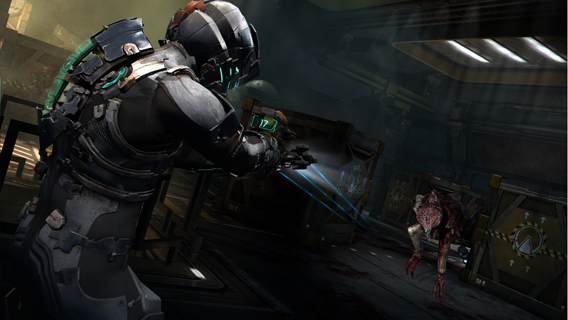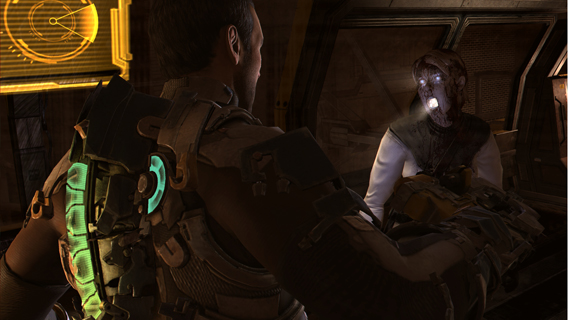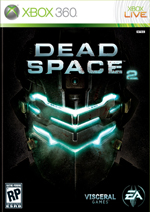
Sometimes the front page is swallowed up by an array of posts about Japanese videogames, and that’s how you, the reader, can know that I will appear and offer relief by instead discussing a game that involves science, shooting, and outer space. Thus, we will now discuss Dead Space 2.
Visceral Games’ sequel opens three years after the end of Dead Space; Isaac Clarke is confined to a mental institution where the necromorphs have mysteriously returned. The opening sequence here is meticulously designed both as tutorial and introduction; Isaac is left to stumble through the halls, bound in a straight-jacket, frantically evading monsters and trying to get to safety. The sequence introduces the player to each of the Dead Space conventions as Isaac scavenges his key tools from machinery throughout the hospital, including a new plasma cutter cobbled together from a flashlight and surgical laser.
 It’s a quick opening, dropping the player immediately into the necromorph disaster, setting a tone that will permeate the entire experience. The necromorph threat is omnipresent and oppressive; even when the enemy is nowhere to be seen, they can be heard and felt rattling in the walls, or howling in the distance, always ready to explode out and attack. Every tool, from sound design to controller vibration, is leveraged to inspire unease and tension in the player, and reaffirm the knowledge that this place is not safe, that the enemy is everywhere.
It’s a quick opening, dropping the player immediately into the necromorph disaster, setting a tone that will permeate the entire experience. The necromorph threat is omnipresent and oppressive; even when the enemy is nowhere to be seen, they can be heard and felt rattling in the walls, or howling in the distance, always ready to explode out and attack. Every tool, from sound design to controller vibration, is leveraged to inspire unease and tension in the player, and reaffirm the knowledge that this place is not safe, that the enemy is everywhere.
Sound design is especially integral to this concern. It’s known that there’s no sound in the void, but in such sequences Dead Space 2 adopts a compromise, where sounds assume a distant, muted effect. This makes the player feel isolated and alone even in battle, maintaining the sensation (if not the absolute truth) of a soundless void. Isaac’s breathing is designed as an indicator of his well being, becoming more and more labored as damage is accumulated, and in silent moments even his heartbeat can be heard.
Isaac himself has also undergone something of an audio-overhaul, now complete with voice and dialogue. This could have easily gone awry; one recalls Samus Aran reading her LiveJournal in Other M, destroying the mental image of the character for gamers everywhere. Isaac fairs much better, seeing great voice acting and some sharp scripting. Consequently, where the first Dead Space was concerned chiefly with a series of events, the sequel is focused far more on Isaac and his odyssey through those events. Isaac feels compellingly sympathetic; perhaps one of the most memorable moments of the game involves the weary engineer collapsing against a wall, staring blankly, overwhelmed by the horror of his own life.

The story also benefits from an improved focus on supporting characters. Although, like Dead Space, most of the game is spent alone, the rare instances where the player meets other characters are far better employed. These are characters the player wants to see; what happens to them matters and informs what the player feels as the game rolls on.
Dead Space 2 is rendered with impressive design, perhaps one of the best looking titles available on consoles today. Lighting and atmospheric effects are applied liberally, making the world feel infinitely more real and interactive. Also to that end, meticulous art design permeates the product, from Isaac’s various armor suits, right down to computer screens and menus. Everything here feels real, and feels used—the way Star Wars used to feel before George Lucas lost his mind. It’s a beautifully grim, satisfying world to be a part of.
One weak point, however, is the design of enemy creatures. Although they are suitably unpleasant to look at, most creatures appear as a mass of gore and bladed limbs—and although it’s not difficult to identify these creatures by their type, most are not particularly interesting, visually. Some larger creatures manage better designs—especially one that is exclusive to zero-gravity areas, which blossoms out of a massive, disgusting organ—but the rank and file soldiers of the necromorph army are sadly boring.
A notable improvement from the original game lies in pacing. Like Dead Space, the sequel is an entirely linear affair, right down to the number and location of enemies in the game, with the only randomness lying in item drops. This makes pacing an absolutely critical concern; if the pace fails to engage, the gameplay might devolve into tired hallway shooting. To this end, a variety of crescendo moments and scripted sequences are employed to keep players sharp. One such moment see’s Isaac sliding on his back through the cars of a crashing train, blasting enemies, before being strung upside down among a horde of approaching necromorphs.
Other stages involve sequences reminiscent of Valve’s Left4Dead games, where activating a device required to move forward triggers the advance of a horde of enemies. The limited resources the game affords put an interesting spin on these sequences, often requiring creative use of powers and items in order to overcome the enemies, where simply laying down ammo is never an effective strategy.

To that end, a fantastic variety of enemies are employed, each with distinct abilities that require distinct strategies. Some enemies approach slowly and attack from range, while others bound forward with startling immediacy. The sequel also employs a greater variety of weaker enemies that demand completely different strategies from the tougher necromorphs, such as the packs of necro-kids, that can’t be dispatched effectively with the powerful, slow-firing weapons, but can be mowed down with the quick-firing but weak plasma rifle.
This is part of a larger strategy to encourage players to use all the tools at their disposal. Where the first game in the series could be won with the plasma cutter alone, better designed weapons and greater variety in enemy and scenario designs requires that players carry a loadout optimized for different situations. To this same end, the kinesis module has been tweaked to be faster, deadlier, and infinitely more useful, while stasis now regenerates (though slowly) to encourage liberal application. The result is that battles have a much improved element of strategy involved, where the goal is not merely to be left alive, but to employ player tools in the most efficient manner possible, and leave each encounter with more resources, not fewer.
However, despite the renewed focus on variety, the mechanics of Dead Space 2 are very much like Dead Space. Few steps have been taken to add distinctive new gameplay elements, with the focus instead being on refining and improving old ones. Much in the way that Dead Space refined standard shooter and survival horror conventions, Dead Space 2 further refines and expands the conventions of its predecessor.
One notable addition, though, is the entirely redesigned zero-gravity sequences. Where Isaac could previously only jump from point to point in straight lines, he is now outfitted with air jets and thrusters that allow him to lift off and maneuver freely in zero-G. These sequences are great fun to control, adding a unique spin to the combat that occasionally occurs within them, and they go a long way toward truly selling the space-based environment.
As is the trend with many high-profile games of late, Dead Space 2 incorporates some RPG elements in the form of item management and persistent character development. This ties into the survival element at the heart of the game, as critical choices must be made with regards to the spending of money, equipment loadouts, the allocation of upgrades, and the decision whether to spend rare upgrade nodes opening item-rich locked doors, rather than improving weapons.
The campaign runs twelve hours, though the constant stress the game imposes makes it feel much longer. Indeed, the experience is extended by the fact that the campaign is difficult to play for more than an hour at a time; the tension becomes so wonderfully oppressive that one must simply take a break after a while.

On that note, the game also offers a multiplayer option. Like many single-player games that have gone multiplayer recently, Dead Space 2 attempts an in-universe approach to multiplayer, where the mode fits loosely into the established single-player story. There’s but one mode to be had, pitting a team of humans against a team of necromorphs, where the humans must complete a series of simple objectives—unique for each map—to achieve victory. A selection of upgrades are offered and some basic loadout customization is available, but the upgrade path is straightforward and the customization far more limited than the current standard for online games.
The multiplayer mode manages to accomplish some unique novelty, however, in its adherence to franchise conventions. The human players are swarmed, non-stop, by necromorphs as they struggle to stick together, maximize their use of supplies and complete objectives. Necromorphs, on the other hand, go down much more quickly—but have superior numbers and a range of abilities that make them dangerous in a variety of situations. Human control adds an interesting twist to the same enemies one encounters in the campaign, with a certain enemy type even being used to snipe unsuspecting human players from afar.
Ultimately, with few maps and a basic progression schedule, the Dead Space 2 multiplayer isn’t likely to influence purchasing decisions; the main attraction is clearly the campaign, as it well should be. However, the mode does offer a surprisingly intense, enjoyable diversion after the singleplayer is complete—or perhaps simply when a break is required from the brutal tension of the campaign.
Replayability is also afforded in the singleplayer in the form of a New Game + option. In addition to new unlocks, subsequent playthroughs offer the option to further upgrade weapons—impossible to complete on a single playthrough. There are five difficulty modes, each affecting enemy strength and item drops, allowing players to choose exactly what level of survival challenge they prefer. The final unlockable difficulty requires the game to be played without checkpoints and offers only three save points, meaning the player must survive or be set back by several hours gameplay–perfect for anyone looking for the most brutal, unforgiving challenge possible.
Dead Space 2 brings a level of refinement and careful expansion to the franchise; it may not bring a wealth of new features to the table, but what is does bring is constructed with impressive, meticulous quality. The incredibly satisfying campaign and enjoyable multiplayer make it, in every way, an improvement over the original and a definitive survival horror experience.
Visceral Games
Publisher
Electronic Arts
System
PlayStation 3, Xbox 360, PC (Xbox 360 reviewed)
Modes
Singleplayer, Online Multiplayer
Release Date
January 25, 2011
*A copy of this title was purchased by Gamesugar for review

Great review Brad. I liked the first one and bought Extraction on Wii a while back as well so I’ll be picking up the CE of Dead Space 2 in a month or so once I’ve got the money and the time for it. But the trophy for finishing the game with only being able to save three times? That’s a marathon run that will probably have to wait.
Comment by EdEN — February 6, 2011 @ 8:01 pm